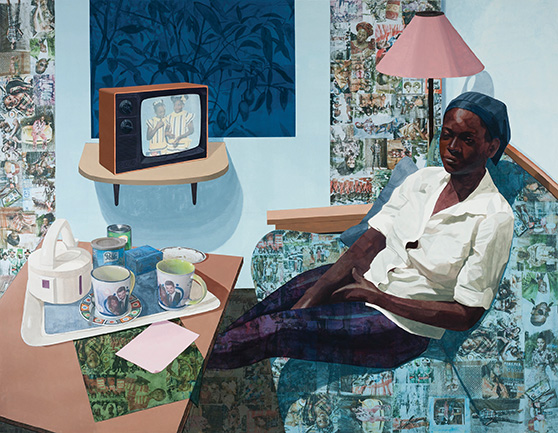For the first time a woman has been nominated by a major party for the presidency of the United States. This summer’s U.S. Olympic team included more women than men. And American art museums are increasingly giving women their due. The Norton Museum of Art in Florida is a good example, as evidenced by its acquisitions of works by American painters Marguerite Thompson Zorach, Grace Hartigan, and Njideka Akunyili Crosby in the last year. We asked the Norton’s executive director, Hope Alswang, to tell us more about the museum’s interest in women artists.

Super Blue Omo by Njideka Akunyili Crosby (1983–), 2016. Norton Museum of Art, West Palm Beach, Florida, purchase through the generosity of Jim and Irene Karp; photograph courtesy of the artist and Victoria Miro, London © Njideka Akunyili Crosby.
The Norton’s three most recent acquisitions of art by women artists span a century, from 1913 to 2016. Other than that they are by women, is there a thread that connects them to each other or to the collection as a whole?
Marguerite Thompson Zorach, Grace Hartigan, and Njideka Akunyili Crosby were born decades apart, in vastly different places, and had very different formative artistic experiences and careers. There is certainly a line of historical development that links these three artists, having to do with many factors—including changing economic and social conditions, the evolution of the art world, and a revolution in the way the work of women artists is received—but it would be a mistake to reduce that complex dynamic to essentialist notions about the choices women artists make in matters such as style, attitude, or subject matter. Beyond that, however, the recent acquisitions of works by women were indeed purposeful, since the Norton, like so many museums, recognizes the need to present a more complex, nuanced, and complete overview of the history of art. Of course these works are all just terrific, and would be welcome in any museum’s collection regardless of the artist’s gender.
Super Blue Omo by Njideka Akunyili Crosby was the talk of June’s Art Basel fair, but the artist is little known to readers of ANTIQUES. Can you expand a little on who she is and why the Norton was keen to acquire the work?
A Nigerian-born American artist, Crosby is a fastrising artist whose work offers a unique perspective on living in America. At Art Basel her Super Blue Omo was offered only to museums, garnering it a lot of attention. By that time, though, the Norton already had its eye on Crosby, as we had featured her in our annual Recognition of Art by Women (RAW) exhibition, which is dedicated to supporting the achievements of living women artists. At the end of each RAW exhibition, the Norton acquires an outstanding work for our permanent collection. So Super Blue Omo was an obvious choice, and we are thrilled to have acquired it.

Bathers by Marguerite Thompson Zorach (1887–1968), c. 1913–1914. Norton Museum of Art, purchase, R.H. Norton Trust; photograph by Jacek Gancarz.
The museum’s website notes that Super Blue Omo is an example of Crosby’s “subtly subversive compositions of her family and native Nigerian popular culture.” Do other works in the collection similarly reflect subversive perspectives—in other words is this a characteristic that has appeared in American art before—or even specifically in American art by women?
In our recent Women Modernists exhibition we presented works by four American artists—Georgia O’Keeffe, Florine Stettheimer, Helen Torr, and Marguerite Zorach—who negotiated the contradictions of representing the New Woman, each in her own way, while making art within an avant-garde that was still maledominated. While painting similar subjects to those chosen by their male counterparts, each of these women developed a highly personal style that left the work open to interpretation, often in terms of gender. There were degrees of subversion—more or less subtle or overt, implicit or explicit—for each. O’Keeffe, of course, remains the best known, not only because of her unusual level of commercial success but also because works such as City Night (1926) defied interpretations of her paintings as expressions of female sexuality.

